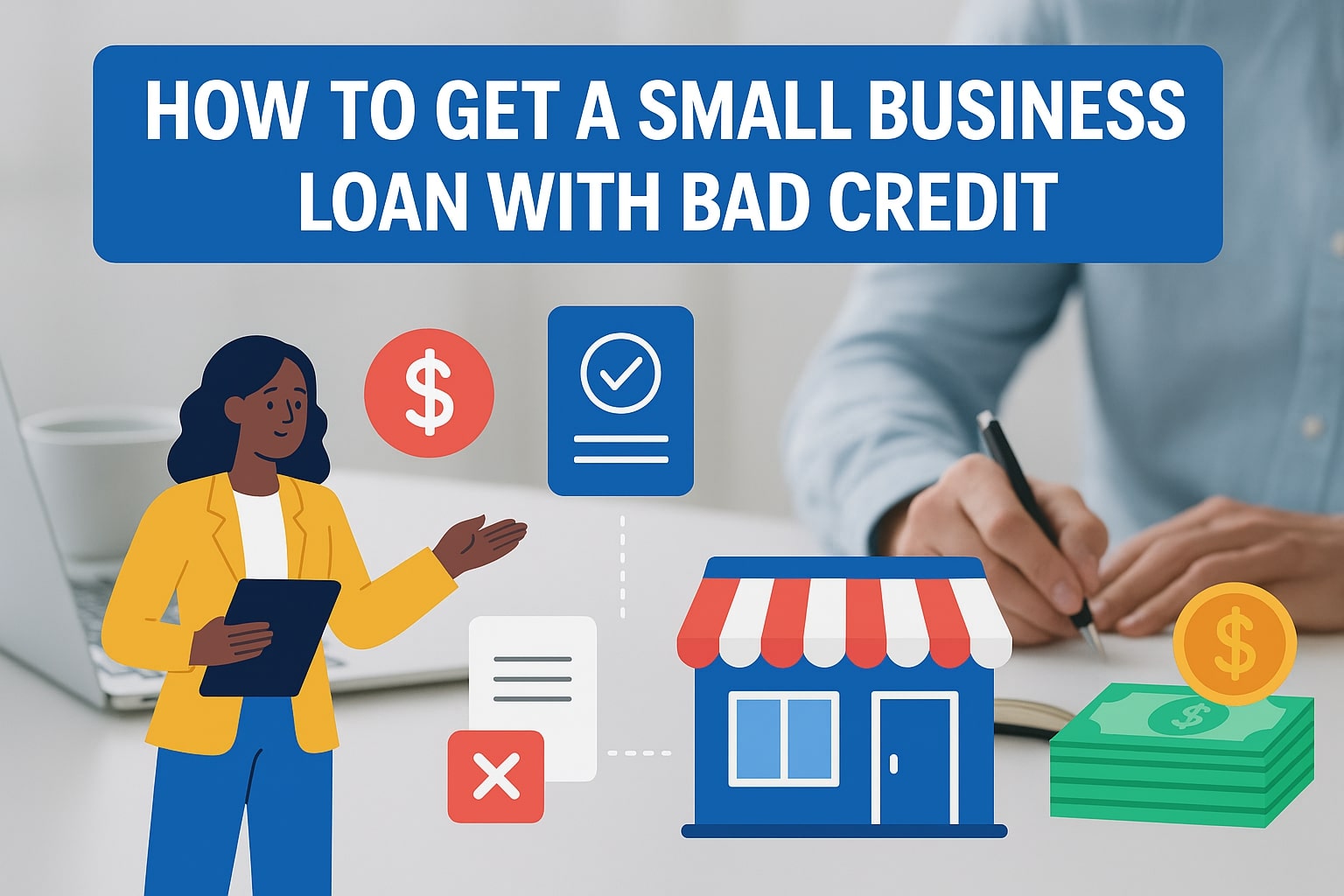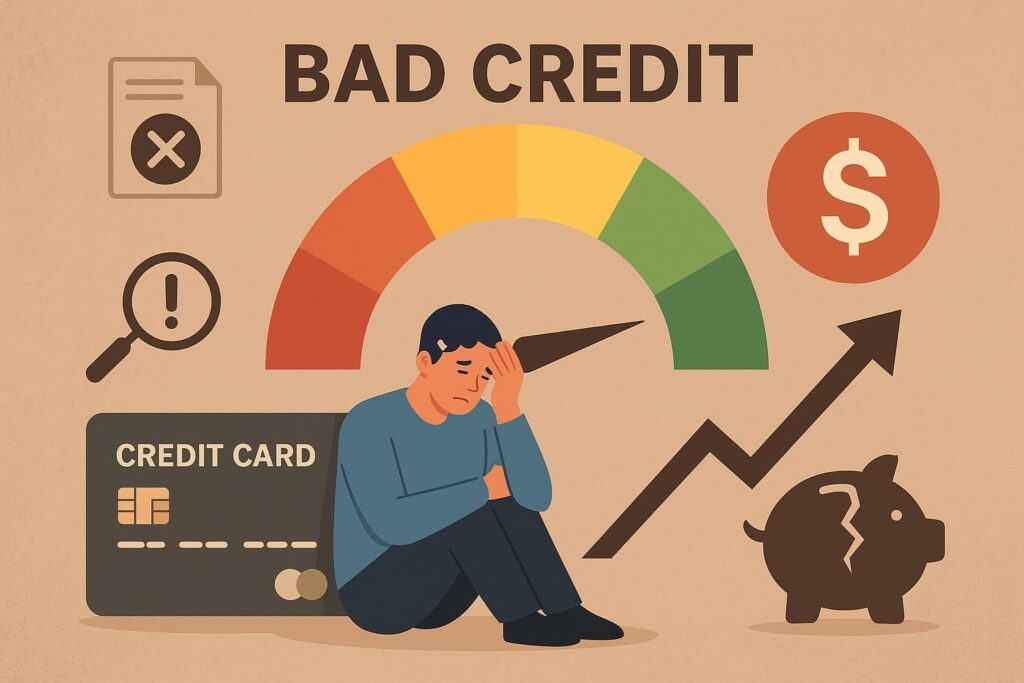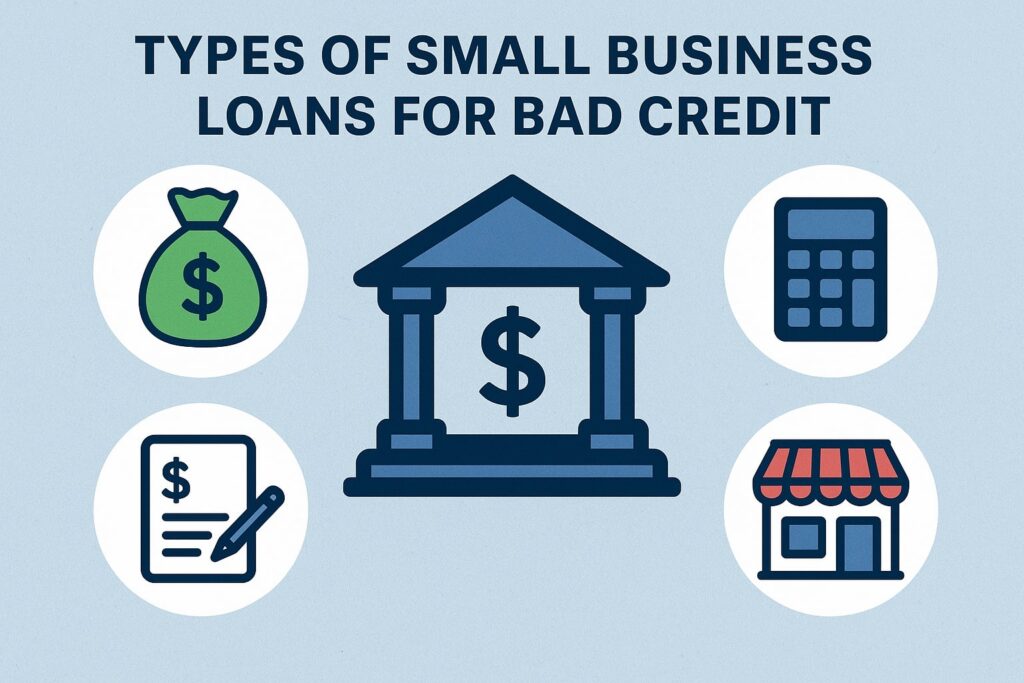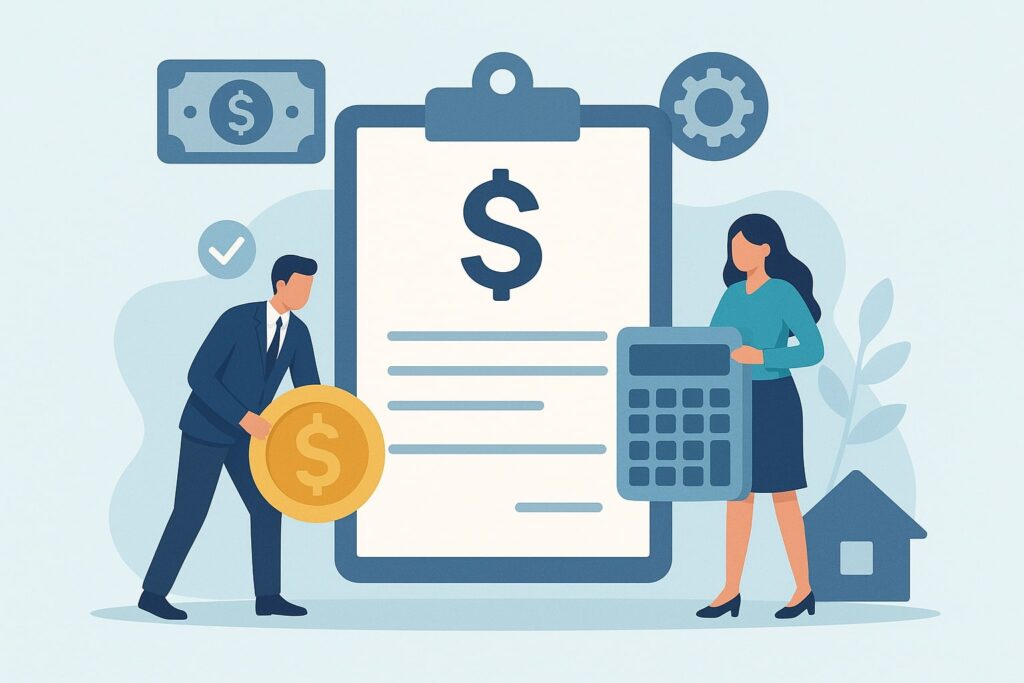
How to Get a Small Business Loan With Bad Credit
Securing financing when your personal or business credit isn’t perfect can be challenging, but it is possible to get a small business loan with bad credit in the United States.
Lenders often rely heavily on credit scores to assess risk, so applicants with FICO scores in the 300–669 range are typically considered “bad-to-fair” credit by industry standards.
While that means stricter loan terms, many loan programs and alternative lenders exist specifically to serve credit-challenged businesses.
For example, SBA microloans provide up to $50,000 through nonprofit intermediaries – averaging about $13,000 per loan – and CDFIs (Community Development Financial Institutions) offer business loans without strict credit minimums.
In this guide we explain the key options, tips, and steps to help a business owner get a small business loan with bad credit. We also include a sample application checklist and a comparison table of common loan types for low-credit borrowers.
The advice and data here are current for the U.S. market (2025) and draw on authoritative sources to ensure accuracy.
Understanding Bad Credit and Its Impact

“Bad credit” generally means a credit score well below what prime lenders require. By consumer standards, FICO scores of 300–579 are considered poor and 580–669 fair. In practice, many traditional banks look for scores in the mid-600s or higher.
For example, one industry guide notes that lenders prefer to see a personal credit score of at least ~670, though some may consider applicants in the low 600s. In contrast, loans designed for bad-credit borrowers allow scores much lower.
Bankrate explains that bad-credit business loans are aimed at owners with personal scores roughly between 300 and 669.
The trade-off is that these loans tend to come with lower approval amounts, shorter terms, and higher fees or interest rates than loans for higher-credit borrowers. In short, if your credit score falls in the bad-to-fair range, you can still find loans, but expect tighter terms and costs.
Credit scores are only part of the picture, however. Lenders also examine your overall financial health, business plan, cash flow, and collateral. SBA notes that even those with bad credit may qualify for startup funding if other factors are strong.
For example, if your business has steady revenue or you can pledge assets as security, you can often compensate for a weak credit history. Similarly, lenders caring more about future sales (like invoice lenders) will emphasize your clients’ creditworthiness over your own.
The key takeaway: poor credit is not an absolute disqualifier; it just means you’ll have to work harder on other fronts (like strengthening your application) and accept more expensive financing.
Types of Small Business Loans for Bad Credit

Several loan categories exist that cater to borrowers with challenged credit profiles. Each has different qualification criteria and use-cases. Below are the main types of financing available to U.S. small businesses with bad credit:
- SBA Microloans and Community Advantage Loans. These are SBA-backed loans (up to $50,000) delivered through specialized nonprofit lenders. The SBA Microloan program provides funding averaging about $13,000.
Because the SBA only guarantees a portion of the loan, the nonprofit intermediaries set credit requirements. Many such lenders have more relaxed standards for underserved entrepreneurs.
For example, SBA Community Advantage loans and microloans often accept borrowers with lower credit scores than traditional SBA 7(a) loans.
The trade-off is that approval can take longer; however, interest rates are generally lower than those of purely private bad-credit lenders.
Most microloans require collateral and a personal guarantee, but they offer multi-year terms (up to 7 years) and rates in the ~8–13% range – far more affordable than typical online short-term loans. - Term Loans (Short- and Medium-Term). These provide a lump sum repaid over a fixed period. Short-term loans (1–2 years) are often used by lenders to mitigate risk with higher-risk borrowers. Some alternative online lenders will fund term loans to business owners even with credit scores in the low 500s.
Standard terms range up to 3–10 years for medium/long term loans. Interest rates vary widely: bad-credit term loans often have APR in the high teens or 20–30%. Borrowers with very poor credit may only qualify for smaller short-term loans at these high rates. - Lines of Credit. A revolving line of credit works like a business credit card: you can draw funds up to a limit, repay, and draw again as needed. This flexibility can be appealing.
Lenders can approve a line of credit with a lower credit score if it is secured or if the borrower meets other criteria. For example, Lendio notes many business lines of credit require only a 600+ personal FICO and about 6 months in business.
However, keep in mind that some lines of credit have variable interest rates, which can fluctuate. Because funds aren’t taken out until needed, approved credit lines can also serve as a source of emergency cash even if you don’t use them immediately. - Equipment Financing. These loans are specifically for purchasing machinery, vehicles, computers, or other equipment. The financed equipment itself serves as collateral, which makes this type of loan easier to qualify for with poor credit.
Many equipment lenders will work with credit scores in the mid-500s or above. Because the loan is secured by the equipment, interest rates are typically lower than unsecured loans, and you can often borrow larger amounts.
Equipment loans usually have terms of 1–5 years. If you default, the lender simply repossesses the equipment, so they are generally less concerned about your credit score. - Invoice Financing (Factoring and Accounts Receivable Loans). If your business issues invoices to other businesses, you can use them as collateral.
In invoice factoring, a lender advances you a large portion (often 70–90%) of outstanding invoices and then collects payment from your clients. In accounts receivable financing, the invoices secure a loan that you repay once customers pay.
The key benefit is that lenders evaluate your customers’ credit, not yours. As a result, most factoring companies do not require a minimum personal credit score. They may, however, require that you have a certain time in business and monthly revenue.
Invoice financing can provide very fast cash (often within a day or two of approval), but it is not free – fees and effective APRs (factor rates) can be significant. This option is ideal when cash is tied up in receivables, and you have customers who reliably pay. - Merchant Cash Advances (MCAs) / Revenue-Based Financing. An MCA company gives your business a lump-sum advance in exchange for a fixed percentage of your future daily credit/debit card sales.
Since repayment comes directly from sales, MCAs usually have no formal credit check. That makes them accessible even if your credit is very poor or you have no credit history.
Qualifying is generally based on your recent sales volume. The major downside is cost: MCAs charge very high fees (often described via a “factor rate” rather than an APR) and can be one of the most expensive forms of financing.
They should be considered only if other options have been exhausted, as experts advise.
Below is a summary comparison of these loan types:
| Loan Type | Credit Score Requirement | Collateral | Key Features / Terms |
|---|---|---|---|
| SBA Microloan | No fixed minimum (often ~620) | Often required (e.g. business assets) | Up to $50K (avg ~$13K); 5–7 year term; interest ~8–13%. Lower rates than private loans, but slower approval. |
| Equipment Financing | Mid-500s or above | Equipment itself | Secured by equipment; loan term ~1–5 years. Often lower rates than unsecured loans. No down payment needed if leasing. |
| Line of Credit | ~600+ | Unsecured (or Personal Guarantee) | Revolving credit, variable rates. Borrow as needed up to limit; useful for fluctuating cash needs. |
| Invoice Factoring | No personal credit check | Customer invoices | Advances 70–90% of invoice value; repay with fee when client pays. Fast funding (1–2 days). |
| Merchant Cash Advance | No credit check (sales-based) | None (repaid via sales) | Advance repaid by daily credit card receipts. Approval is easy, but fees/factor rates are extremely high. |
| Short-Term Unsecured | 500+ (varies widely) | None | Loans under 1–2 years. APR often 20–30% or more. Fast approval (often same-day to a few days). |
Table: Comparison of common bad-credit business loan options (U.S. context). Sources: SBA, Lendio, Bankrate, and industry data.
Alternative Lenders and Specialized Programs

Traditional banks and big national lenders usually prefer strong credit, so many small businesses with poor scores turn to alternative sources:
- CDFIs and Community Lenders. Community Development Financial Institutions (CDFIs) are mission-driven banks or non-bank lenders that target underserved markets (including low-income or minority-owned businesses).
By charter, many CDFIs “tailor loans to fit people, not a credit box.” They often eliminate traditional barriers like high credit scores or long time-in-business requirements.
For instance, Accion Opportunity Fund (a leading CDFI) will consider applicants with personal scores as low as 600 and requires only $50K in annual revenue. CDFIs may also offer business coaching and other support in addition to loans.
To find CDFIs in your area, use resources like the U.S. Treasury’s CDFI database or the Opportunity Finance Network’s locator.
Bear in mind CDFI loans typically take longer to process than online lenders, but they usually have fair rates (often as low as 8–10% APR) and higher approval odds than conventional banks. - Online Fintech Lenders. Companies like OnDeck, BlueVine, Kabbage (now Fundbox), and others have emerged to serve small businesses. They use technology and alternative data (like daily sales) to underwrite loans.
Many online lenders explicitly accept weaker credit. For example, a finance platform survey found lenders offering funding to scores in the low 500s. Lending marketplaces (e.g. Lendio, LendingTree) also compile lists of lenders willing to work with bad credit.
These fintech loans tend to be funded very quickly (often within a few days) and have less paperwork. However, the convenience comes at the cost of high interest/fees.
As Bankrate cautions, be vigilant: avoid any lender that promises “guaranteed approval,” pressures you to sign, or tacks on exorbitant upfront fees. - SBA 7(a) Loans. The flagship SBA 7(a) loan usually has stricter requirements, but it can still be an option if you have bad credit and other strengths (like collateral).
Individual SBA-approved banks and credit unions set their own bar, but having strong business metrics can help you overcome a low personal score. Lendio explains that showing “solid cash flow” or valuable collateral can offset a credit blemish in an SBA 7(a) application.
In general, SBA loans need more than 2 years in business and a score in the mid-600s, but exceptions exist for credit-challenged applicants if the lender sees a strong case. Be aware that even SBA loans with “bad credit” can take 1–2 months or more to process. - Cooperative and Community Banks. Local credit unions or small banks may have programs for local businesses and sometimes adopt a more personal approach.
If you have an existing banking relationship or belong to a credit union, it’s worth asking what flexibility they offer.
These institutions often emphasize the “character” of the borrower and community ties, sometimes taking on a borrower with past credit issues if other aspects are solid. Always compare any such offer carefully to online alternatives.
Strategies to Improve Loan Approval Chances
Before applying, you can take steps to strengthen your profile or application. These efforts will not only increase your chances but might also lower your loan’s cost. Key strategies include:
- Improve your credit score (if possible). This is easier said than done, but even small improvements can help.
Pay down credit card balances, make sure all current bills and loans are on-time, and check your credit reports for errors (dispute any inaccuracies). Every timely payment and lower balance will gradually raise your score.
The SBA and experts note that improving credit – even raising it by a few points – makes lenders more willing to consider you. Be patient: credit rebuilding takes months, but it’s worth it if you have the luxury of time. - Assemble collateral or guarantees. Offering collateral (assets like equipment, real estate, or inventory) can open doors. If you can pledge something of value, many lenders will overlook a low credit score.
Lendio explicitly advises that collateral like large equipment or property gives lenders confidence and expands your options.
The SBA notes that some SBA loans don’t require collateral (if other conditions are met), but for most bad-credit business loans you’ll need to provide something of worth. Even a cosigner with strong credit can serve as a sort of “guarantee” on the loan. - Find a co-signer or personal guarantor. A cosigner with a good credit history dramatically improves approval odds. This person (often a family member or business partner) legally agrees to repay the loan if you default.
Lendio points out that adding a trusted cosigner with solid credit can overcome your own score deficiencies. Be sure anyone who cosigns understands they bear the risk if you can’t pay. - Boost your cash flow and financial documentation. Lenders want assurance you can repay. Strengthen your application by showing steady or improving cash flow, a clear budget, and reasonable debt levels.
If necessary, tighten expenses or increase prices in advance of applying, to make your finances look stronger. The more you can demonstrate liquidity or reserves, the more comfortable a lender will feel lending to you. - Craft a solid business plan and pitch. A detailed business plan signals seriousness and competence. Include clear projections, growth plans, and explanations of how you’ll use the funds.
If poor credit is a concern, address it head-on in your pitch – explain any past issues (for example, a one-time event or market downturn) and emphasize how you’ve improved your operations since.
As Bankrate notes, telling your story and providing context helps mitigate lenders’ concerns about credit history. Showing collateral schedules or insurance policies can also help. - Apply selectively and research lenders. Don’t just apply to the first lender you find. Different lenders have different criteria. Use marketplaces or broker services to compare multiple offers without repeated hard credit pulls.
Some portals (like SBA Lender Match) can match you with institutions more likely to accept weak credit.
Also, narrow your search to lenders who explicitly cater to credit-challenged businesses (your research should reveal which ones specify “poor credit OK”).
Loan Application Checklist
When you’re ready to apply, have all the necessary documents organized. Below is a sample checklist of items most lenders will ask for (requirements vary by lender and loan type). Gathering these in advance ensures a smoother process:
- Business Plan & Projections: A detailed plan outlining your business model, market, how you will use the funds, and financial projections (profit & loss, cash flow, balance sheet).
- Personal Background: Personal resume or background information for each owner or guarantor, including experience, previous addresses, and any explanations of past credit issues.
- Credit Reports: Your personal credit report (from all three bureaus) and, if available, your business credit report. Review these in advance and correct any errors.
- Tax Returns: Complete personal and business tax returns for the past 2–3 years.
- Financial Statements: Recent financial statements (usually the last year or two of profit & loss, balance sheet, and cash flow). If you own >20% of the business, you may need to submit signed personal financial statements.
- Bank Statements: Typically 6–12 months of personal and business bank statements to prove your cash flow and account history.
- Collateral Documents: If offering collateral, documents proving ownership and value – such as equipment invoices, real estate deeds, or inventory lists – along with appraisal or sale price information.
- Legal & Business Documents: Business licenses, registrations, articles of incorporation, or partnership agreements, as well as any significant contracts (leases, customer/supplier contracts).
- Identification: Valid IDs of the owners/guarantors (e.g. driver’s licenses or passports).
- Other: Depending on loan type, you may need additional items (for example, accounts receivable aging reports for invoice financing, or vehicle titles for certain asset loans).
Collecting and organizing these documents ahead of time will speed up the underwriting process. The SBA and credit unions emphasize reviewing and preparing accurate documentation as a critical step.
Frequently Asked Questions
Q: Can I really get a small business loan with bad credit?
A: Yes. Many lenders specialize in “bad credit” borrowers. These include online funders, SBA intermediaries, and CDFIs. These programs have more flexible approval criteria, though they typically have higher interest rates or fees.
As Bankrate summarizes, “business loans for bad credit are often available” even with FICO scores down to 300, but they carry stricter terms. The key is to compare options and be prepared with collateral or a cosigner to improve your chance.
Q: What is considered a “bad” credit score for a business loan?
A: There’s no universal cutoff, but generally, a personal FICO score below ~580 is considered poor, and 580–669 fair. Many traditional lenders like banks prefer 680+. If your score is below 600, you’re in the “bad credit” range.
However, some lenders expressly accept 500+ scores. Remember, lenders look at business credit (if available) and other factors too. Focus on strengthening other parts of your profile if your score is low.
Q: Is my business credit score important?
A: Yes, if you have an established business credit profile, lenders will consider it along with your personal credit. However, for many small business loans (especially small or startup loans), the owner’s personal credit score is the primary factor.
So even if your business is new, your personal credit is what many lenders will use. If you lack both, consider stepping stones like starter business credit cards or small lines of credit to build a business credit history over time.
Q: Will SBA loans help if I have bad credit?
A: Potentially. The SBA Microloan and SBA 7(a) programs can be options for low-credit borrowers. SBA Microloans (through nonprofits) often have more relaxed credit checks. An SBA 7(a) loan from a bank is harder to get with bad credit, but not impossible.
Lenders may approve an SBA loan if you offer strong collateral, a solid business track record, and evidence of good cash flow. The SBA emphasizes that lenders look at the whole picture – if you can make a strong case with other strengths, you can overcome some credit issues.
Q: What can I do if my credit is too low to qualify for any loan?
A: If traditional loans are still out of reach, consider alternatives:
- Self-funding or partners: Using personal savings or finding an investor/partner can bypass the need for debt.
- Business grants or community programs: While rare, small-business grants or local economic development loans (from cities or states) may be available for qualifying businesses.
- Crowdfunding: Platforms like Kickstarter or GoFundMe can sometimes raise seed money without credit checks (though typically suitable for product-driven startups or nonprofit projects).
- Credit cards: As a last resort, a business credit card (personal or secured) may provide short-term funds, but interest rates are high. Only use this if you’re confident in quick repayment.
Q: How can I avoid scams or predatory lenders?
A: Very important. Watch out for lenders who: promise guaranteed approval regardless of your info, ask for large upfront “processing” fees, or use high-pressure tactics.
The SBA advises checking that interest rates and fees are transparent, avoiding any offer that looks too good to be true, and comparing multiple offers.
Legitimate lenders will never ask you to misstate information or leave parts of the application blank. Always verify the lender’s credentials, read reviews, and consult your accountant or attorney if in doubt.
Conclusion
A poor credit score doesn’t have to be a dead end for your small business financing. By understanding the landscape of business loans for bad credit and strategically preparing, you can unlock funding to grow your company.
Key steps include researching specialized loans (like SBA microloans, CDFIs, and alternative lenders), improving your financial profile where possible, and presenting a complete application.
Remember that lenders will scrutinize every aspect of your business when your credit is weak, so bolster your case with strong revenue proof, collateral, or guarantees. Use the comparison table and checklist above to guide you through the options and requirements.
With persistence and planning, you can get a small business loan with bad credit and take a step toward rebuilding your credit and growing your enterprise.